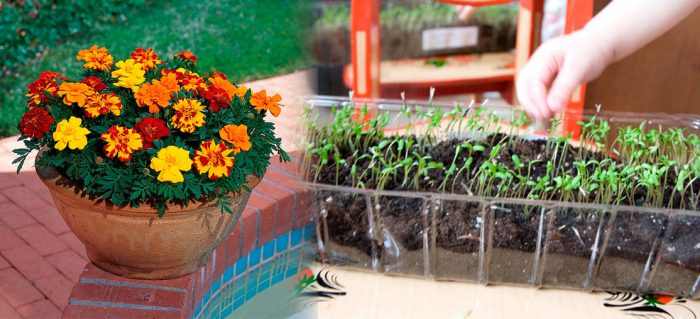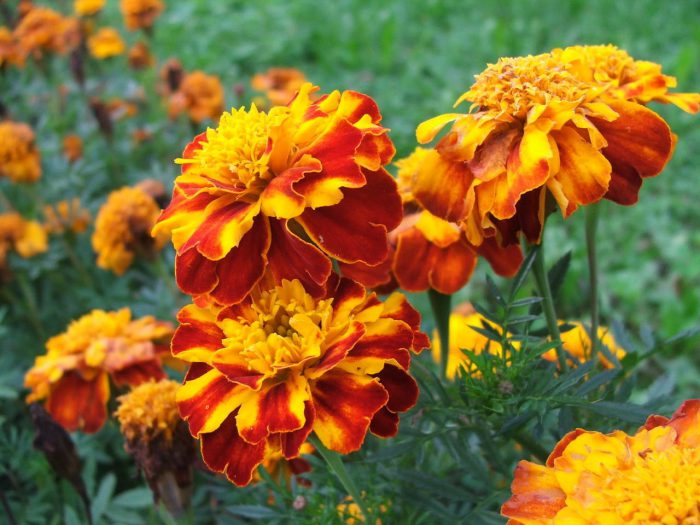This flower has more than one name, among which there are such as lights, black shaves, hats, marigolds, etc., but it has a scientific name such as tagetes. He is very popular among flower growers and is a universal favorite. In the flower beds, you can find both dwarf varieties and varieties - giants. Planting seedlings is not so difficult and even a novice florist can cope with this task.
Content
Advantages of marigolds
Depending on the variety, tagetes can bloom with inflorescences of various shapes: from small "carnations" to luxurious "chrysanthemums", which has a varied shade - from red-brown to lemon-yellow. These flowers can be planted in flower beds or in small containers. They can close places in a flower garden that are bare after other flowers bloom. The value of tagetes lies not only in decorative possibilities. In the stems and other parts of the plant, natural phytoncides are present, which actively scare off various pests, and also inhibit the growth of pathogenic fungi located in the growth zone of marigolds.
Marigolds can be planted on strawberries to scare away the weevil, and if they are planted on cabbage, they will protect the cabbage from the invasion of the whites. If planted next to other flowers such as phloxes and clematis, it will save these flowers from nematodes. If planted next to asters, then marigolds will help them protect themselves from fusarium.
Tagetes is interesting as a medicinal plant and also a spice.
How to sow marigolds for seedlings
This plant propagates by seeds, which are planted in the ground after frost, after which, when they sprout, they can be thinned out or young seedlings can be transplanted so that they feel more free. In order for the flowering of marigolds to be earlier, it can be planted during this period not with seeds, but with full-fledged seedlings.
From the moment when the tagetes rose to the moment when it begins to bloom, it takes from 40 to 50 days. Based on this, marigolds for seedlings should be sown in the first decade of April. To do this, you need to prepare a substrate from the following components: peat, compost (humus) and washed sand in a ratio of 2: 1: 0.5. The main thing is that the mixture is loose and fertile.
Sowing marigolds for seedlings
To prevent Tagetes seedlings from dying from the black leg, the prepared substrate must be treated with a solution of "Maxim", "Vitaros", "phytosiorin" or a solution of potassium permanganate. Alternatively, you can steam the prepared potting mix in a double boiler for 1 hour. This will help get rid of not only the spores of pathogenic fungi, but also weed seeds.
After the mixture is processed, it is poured into a container and slightly compacted, after which grooves are made on the surface, 0.5 cm deep, while the substrate should not have much moisture. After that, the seeds of marigolds are neatly and evenly distributed over shallow grooves.
Since the seeds are not large, tweezers can be used. Then, the decomposed seeds are covered with the same substrate. Its thickness should be within 1cm. If they are planted under a layer less than 1 cm thick, then at sunrise, the peel from the seeds remains on the young seedling and will not allow it to develop normally.
In order for the crops to grow normally and on time, they need to be slightly moistened.
Cover the crops with a suitable lid, and then move to a bright place. Already after 5-7 days, the first shoots may appear if the optimal temperature regime is maintained, within + 15-20 ° C. At temperatures below + 15 ° C, Tagetes seeds germinate very poorly, and at temperatures above + 25 ° C, they may not germinate at all.
As soon as the first shoots begin to appear, the room should be constantly ventilated, since during this period there is a very high probability of damage to young shoots with a black leg. At the first signs of the appearance of this disease, you need to immediately remove the lodging seedlings along with the ground, sprinkle the holes with fresh soil and treat with a fungicide.
When friendly shoots appear, the film must be completely removed. You can water when the soil in the container dries out. In order for young seedlings to harden faster, they can be fed with fertilizers for seedlings every two weeks.
As soon as 2-3 leaves appear, the plant can be dived.
Marigold picking
After the appearance of 2 real leaves, tagetes is ready for a pick. At the same time, the young plant sinks into the soil almost completely, to the border of the lower oblong leaves, while they should not touch the ground.
You can cut young plants into a seedling box. Marigolds tolerate transplanting well even in a state of flowering, while an earthen lump may not be preserved. As practice has shown, it is better to grow Tagetes seedlings in cassettes. For this, a substrate of the same composition is used as for sowing, but without sieving and with the addition of 1 tablespoon of mineral fertilizer, containing nitrogen, potassium and phosphorus, and half a glass of wood ash for every 5 liters of substrate. Fertilizers must be evenly distributed in the mixture, and for this the substrate must be well stirred.
After that, the cassettes are filled with substrate and compacted, but not much. Then, deepenings are made in the soil so that the roots of the seedlings are freely placed in them. If the roots do not fit, then they can be reduced, the plant is not afraid of this. The seedlings are deepened to a depth of 1 cm.
In conclusion, they must be carefully watered. As a rule, after watering, the land settles, so fresh substrate should be added on top. This plant does not like moisture overdose, therefore, it is better to underfill than to pour.
Planting marigolds in the ground
In order for the flowers to take root well and not start to hurt, they need to be accustomed to fresh air, about 2 weeks before planting. It is possible to plant seedlings in the ground only when there are minutes of the threat of frost, otherwise the young plants will die. This is somewhere in the end of the first decade of June. They are planted in a sunny place, although tagetes feels good in the shade, but the flowering will not be so abundant.
Any soil will do for this plant, the main thing is that it is water and air permeable. If there is clay soil, then it is better to dilute it with peat and sand.
In the landing sites, the soil is dug to the depth of the shovel bayonet, after which nitroammophoska is introduced at the rate of 30g per 1 square meter and dug again. Plants are planted at a distance of 30 cm from each other, after making holes.As a rule, the recommended planting distance is indicated on the seed packaging. The main thing is to adhere to the recommendations, if there is no experience of planting tagetes.
Basically, all flower growers keep all the bags where the plant variety and recommended distances are indicated. Young plants are planted to a depth of 1-2 cm.
To do this, you need to place the root of the plant in the hole, after which all the voids around the root system are filled with the same soil and slightly compacted.
In conclusion, you can water the newly planted seedlings, while you can water it safely through the leaves.
In order for marigolds to develop normally, they need care, which consists in regular weeding of row spacings to provide oxygen access to the root system and at the same time get rid of weeds. To ensure lush flowering, it is recommended to feed the plant with potassium-phosphorus fertilizers 1-2 times per season. It is not recommended to use nitrogen fertilizers, as tagetes will increase the green mass, and may forget about flowering.




























